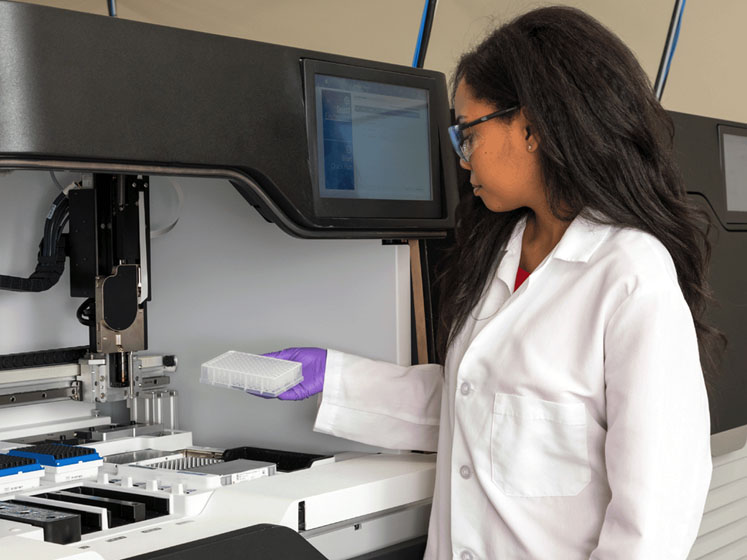Gene therapy research is at the forefront of the effort to develop treatments for conditions including rare diseases such as haemophilia and, more recently, neurological diseases including Parkinson’s and Alzheimer’s.1,2
In the UK, the NHS has approved several gene therapies for the treatment of rare genetic conditions and the country is one of the leading hubs for gene therapy research — representing 9% of all global advanced therapy medicinal product (ATMP) trials.3,4
For many of the breakthroughs in gene therapy research, scientists can thank advances in genomic sequencing. A complete and accurate view of genetic material is what underpins the development of safe and effective gene therapies.
Researchers need to discover precisely which variants are potentially responsible for disease and have confidence in any genetic changes they propose. Today, one of the most actively investigated gene therapy research vehicles is the recombinant adeno-associated virus (rAAV), which can be engineered to deliver DNA to target cells.

Accuracy and completeness
One of the key factors driving rAAV research is that they are non-pathogenic; most individuals will not elicit an immune response to eliminate the virus or cells that have been successfully modified by rAAV. Other advantages include low toxicity, reduced host genome integration and strong vector persistence.
To date, one of the challenges in rAAV therapy research has been achieving the right level of vector quality during the discovery, design and production of gene therapy products. The rAAV genome is a single stranded DNA molecule about 4.7 kilobases long.
The ability to see the entire length of the genome is important in terms of discovering truncated products and chimeras, whereas high accuracy is needed to identify undesired mutations.
However, commonly used short-read and qPCR methods typically miss these important changes as they are limited to 50–300 bases, significantly less than the 4700 that make up the rAAV strand. This lack of insight could impact the safety and efficacy of gene therapy products.
Third-generation sequencing transforms rAAV
The good news is that developments in long-read sequencing technologies are delivering deeper insights into rAAV genomes. Third-generation single molecule, real-time (SMRT) sequencing allows researchers to comprehensively profile rAAV genomes as a single intact molecule with high accuracy to reveal otherwise difficult-to-detect variations.
This is in contrast to qPCR methods that can only confirm the size of the AAV molecule or short read methods that require stitching together small fragments of DNA (and sometimes miss unexpected issues). Other long-read technologies are limited by accuracy and cannot resolve similar AAV species and/or quantify their prevalence.
We’re already seeing the benefits of SMRT sequencing innovation. In one study, researchers used the technique to reveal impurities that were missed by short-read methods.5
The SMRT technology identified sequences originating from the plasmid backbone and helper plasmids, showing that vector populations contained between 1.3% and 2.3% of the unexpected material.
These discoveries redefine quality control standards for viral vector preparations, highlighting the potential degree of foreign products in rAAV-based therapeutic vectors.

Researchers are also using third-generation sequencing to identify host integration events. Integration has been associated with tumorigenesis in mice, so understanding potential host integration events is important when researching gene therapy products.
For example, researchers looking at liver cells used long-reads to reveal chromosomal integrations at a surprisingly high frequency of 1–3% both in vitro and in vivo.6 Such knowledge is key to understanding potential safety risks when researching new gene therapies.
A new era for gene therapy
Gene therapy is at inflection point … but there are still technical challenges to overcome in terms of product safety and efficacy. Third-generation long-read sequencing can help to enable the development of these products with highly accurate and complete insights into rAAV genomes.
As long-read technologies become faster and more affordable, the field will likely see more effective gene therapies become available that cover a broader range of diseases.
References
- www.nature.com/articles/s41576-019-0205-4.
- www.ncbi.nlm.nih.gov/pmc/articles/PMC8887624/#:~:text=Adeno%2Dassociated%20virus%20(AAV)%20has%20been%20the%20vector%20of,gene%20transfer%20to%20the%20CNS.
- www.genomicseducation.hee.nhs.uk/blog/new-gene-therapy-launches-in-the-uk/.
- https://ct.catapult.org.uk/news/press-release-cell-and-gene-therapy-catapult-launches-2021-clinical-trials-database-report.
- www.cell.com/molecular-therapy-family/methods/fulltext/S2329-0501(18)30014-7.
- www.cell.com/molecular-therapy-family/molecular-therapy/fulltext/S1525-0016(21)00440-8.
